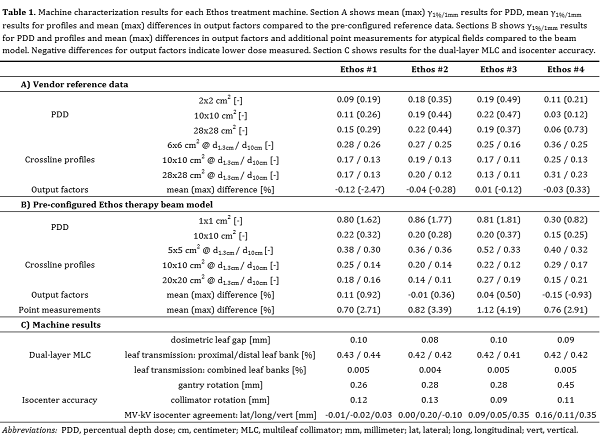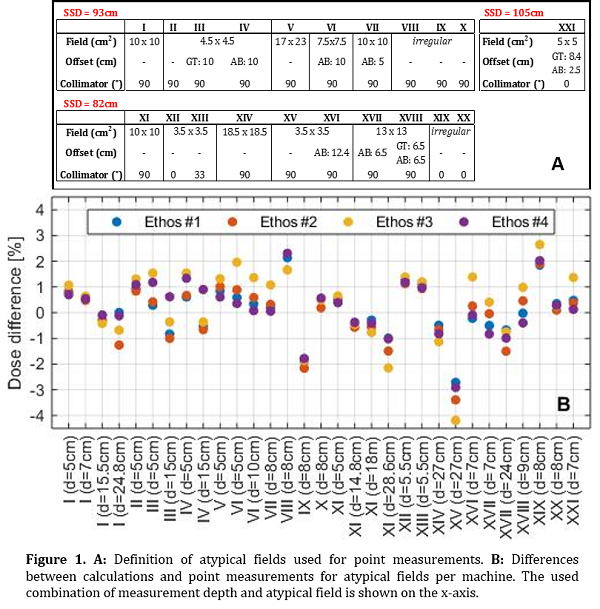Characterization of Ethos therapy systems for adaptive radiotherapy: a multi-machine comparison
Stijn van de Schoot,
The Netherlands
PO-1611
Abstract
Characterization of Ethos therapy systems for adaptive radiotherapy: a multi-machine comparison
Authors: Agustinus van de Schoot1, Daan Hoffmans1, Karel van Ingen1, Martijn Simons1, Marjan Admiraal1, Niek van Wieringen1, Jan Wiersma1
1Amsterdam UMC, Radiation Oncology, Amsterdam, The Netherlands
Show Affiliations
Hide Affiliations
Purpose or Objective
The
Ethos therapy system (Varian Medical Systems) allows for CBCT-guided on-couch
adaptive radiotherapy using artificial intelligence. Clinical treatment
involves treatment preparation and plan adaptation using Ethos treatment management with
a pre-configured beam model. Besides adequate quality assurance, accurate machine
characterization and beam model verification is necessary for patient interchangeability
between treatment units. Our aim was to investigate the dosimetric and
mechanical characteristics of Ethos therapy systems including beam model
verification and determine the variation between clinical systems.
Material and Methods
Four
Ethos treatment units, consisting of a 6-MV FFF beam with a dual-layer MLC and
kV-CBCT system for image guidance, were recently introduced clinically. Before
introduction, a comprehensive protocol was used for machine characterization
and beam model verification including relative dosimetry measurements. Percentual
depth dose (PDD) curves, profiles and output factors (OF) were obtained by
direct measurements in a water tank and compared to vendor-provided reference
data. For beam model verification, additional PDD curves, profiles and OF were collected
and compared to beam model based calculations. Differences for PDD curves and
profiles were quantified using 1D γ-analysis (1%/1mm). Also, point measurements
at different depths were obtained for atypical field configurations including
off-axis fields with non-standard source-surface distances (Figure 1A). Differences
between measurements and calculations were quantified. Next to relative
dosimetry, machine characterization consisted of leaf transmission verification
for individual and combined MLC banks and dosimetric leaf gap (DLG)
determination. The DLG was assessed by deriving the intercept of the fitted
linear relation between leaf gap and measured output. Also, the isocenter
accuracy for gantry and collimator was assessed by determining the diameter of
the radiation isocenter using spoke-shot tests. The agreement between beam
isocenter and kV-CBCT isocenter was verified by calculating MV-based and
CBCT-based phantom alignment differences.
Results
For
all machines, a good agreement was found between reference data and
measurements and between calculations
and measurements. Table 1 shows OF results and mean γ1%/1mm results
for selected PDD curves and profiles. Mean differences of approximately 1% were
found for point measurements of atypical fields. For all machines, largest
differences were found for measurements with irregular fields or large depths (Figure
1B). Furthermore, limited machine variation was found in terms of MLC
performance and isocenter accuracy (Table 1).


Conclusion
This
study demonstrates excellent agreement between Ethos therapy systems and
pre-configured beam model as well as minimal variation in Ethos therapy systems
in terms of dosimetric and mechanical characteristics. Moreover, the results provide
benchmark data for future Ethos therapy system installations.